Saturday, May 15, 2010
Friday, May 14, 2010
Toss it..
From the A.O.M. blog:
-
7 Baseball Pitching Grips Every Man Should Know

As a Little Leaguer, I spent countless hours learning and mastering several pitching grips. For me, the grips to throw breaking balls or fastballs were akin to the grips of a secret society. I felt I was taking part in a secret baseball tradition that went back for generations and that by mastering them I would unlock an occult baseball power that would make me unstoppable on the mound. Yeah, I was a nerd.
While I was throwing the ball around with my brother a few weeks ago, I realized that my pitching skills had gotten a little rusty since my younger days. I was having a hard time putting that spin on the curveball and making the splitter sink correctly. So I did some reviewing and figured I’d share with you all what I learned. Whether you’re just wanting to throw the ball around for fun or you want to initiate your son into the secrets of pitching, here are the ins and outs of the 7 baseball pitching grips every man should know.
Four-seam Fastball
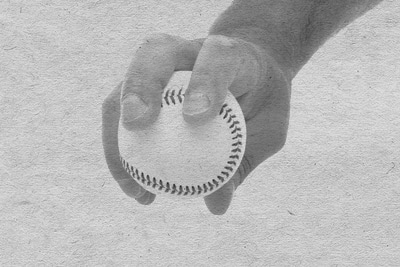
This is probably the first baseball grip you learned when you first learned how to throw a baseball. The four-seam fastball is fast, but it also affords pitchers a great amount of control over where they place their pitch.
To grip a four-seam fastball, place your index and middle fingertips across the perpendicular seams of the baseball. Place your thumb directly underneath the ball. Your thumb tip should rest on smooth leather, not on a seam.
When holding the baseball, don’t smother the ball close to your palm. Hold it more by the fingertips so that the ball is as much as an inch away from the palm. This ensures that there’s the least amount of friction between your hand and the ball. Less friction means the ball can leave your hand faster.
Throw the ball at full velocity. When the ball is released, the batter will see four parallel seams spinning towards him, hence the name “four-seam fastball.”
Two-seam Fastball
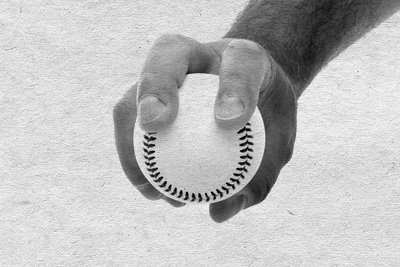
The two-seam fastball is about 1 to 3 MPH slower than the fastball, and it sinks to some degree (though it’s not a breaking pitch). Because there’s a bit of movement with the two-seam fastball, batters can have a hard time getting a solid hit on it. In addition to the slower speeds, the two-seam fastball offers less control to the pitcher than the four-seam fastball.
To grip a two-seam fastball, place the index and middle fingers directly on top of the narrow seams as shown in the picture above. Place your thumb directly underneath the baseball. Your thumb tip should touch the smooth leather, not the seam.
Unlike the four-seam fastball, you want to hold the ball tighter and closer to your hand with a two-seam fastball.
Throw the ball at full velocity. When you release the ball, the batter will see only one pair of horizontal seams spinning towards him.
Circle Change-up
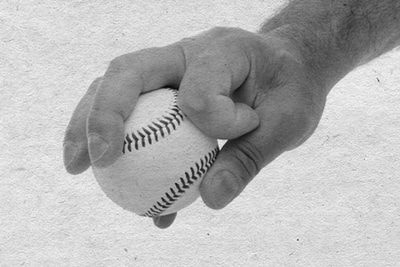
After you’ve thrown a few heaters at your batter, he’ll start to get a sense of your timing. That’s when you want to throw him off with a change-up pitch. A change-up looks just like a fastball, except when the ball leaves your hand it does so much more slowly. When throwing a change-up, your arm velocity and body mechanics should be exactly the same as when you’re throwing a fastball. The only difference is the grip. Because it looks like you’re throwing a fastball, but the ball is moving slower, the batter will usually swing too early, either missing the ball completely or fouling it off.
There are several change-up grips, but my favorite was the circle change-up. Make a circle with your thumb and index finger like you’re giving someone the “okay!” sign (Note: unless you want to get smacked, don’t make the “okay” sign while visiting Latin America or any of the Mediterranean countries). Place the ball in your palm and hold it with your three other fingers. The ball should fit nice and snug against your circle.
When you pitch the ball use the exact same arm speed and body mechanics as you would with a fastball. For a change-up to be effective, you need to sell the batter that you’re throwing him another fastball. The grip will slow the ball as it leaves your hand.
Pedro Martinez of the Philadelphia Phillies has a killer circle-change up.
Curveball

The curveball is a great pitch to have in your arsenal in order to throw off and fool batters. A curveball slightly sinks as it reaches the catcher’s glove. Moreover, when thrown correctly, a curveball can appear to be outside the strike zone, but then suddenly break back in towards the plate so that it’s a strike.
How does a curveball make these movements? Well, part of it is an optical illusion. When we look at a curveball with its unique spin in our periphery, the ball appears to curve more than it actually does. This demo explains it nicely.
But the curve of a curveball isn’t all illusion. It does indeed break a bit on its path towards the plate. Unlike fastballs that rotate from bottom to top, curveballs rotate from top to bottom. In order to get that spin, it starts with the grip. Place your middle finger along the bottom seam of the baseball and put your index finger right next to your middle finger as shown in the picture above. The placement of your middle finger along the seam of the ball will give it a tight rotation so it can break. Place your thumb on the back seam of the baseball. So, there’s the curveball grip. But that’s only the first part.
The delivery of the curveball is a bit different than the fastball. First, when throwing a curveball, you want to keep your elbow equal with or slightly above your throwing shoulder. This will reduce the amount of stress placed on your arm when you rotate your wrist. Also, try to release the ball closer to your body than you would with a fastball, as this will result in tighter rotation.
When you release the ball, rotate your thumb upwards, and your middle and index fingers downward. To do this, simply rotate your wrist out and down. You want the ball to rotate off your index finger when it leaves your hand. This twist in your wrist will give the ball its forward top-bottom rotation that will make the ball break.
Because of the shortened arm action and the rotation on the ball, curveballs are much slower than fastballs.
The curveball has been around since the 1870s. Historians debate whether Fred Goldsmith or Candy Cummings invented the pitch. Notable curveball pitchers include Steve Carlton, Nolan Ryan, Dwight Gooden, and David Wells.
Slider

Hitting legend Ted Williams once said that “the slider is the best pitch in baseball.” Sliders drive batters batty because they’re faster and break much later than curveballs. When the ball does break, it does so laterally and down.
Position the ball much in the same way as you would position a two-seam fastball, only now place your middle and index fingers next to the right seam as shown in the picture above. Your ring finger should rest on the side of the ball. Place your thumb directly underneath the ball on the smooth leather. Squeeze the ball between your middle finger and thumb.
Arm speed is the same as a fastball. You don’t have to twist your wrist when you throw it because the way you’re holding the ball will create the spin necessary for the ball to break. Just make sure you keep your wrist loose so you can get a nice wrist-snap; this will give the ball more spin when you release it. If you gripped the ball correctly, it should spin off your index finger from the outside of the ball.
John Smoltz had an almost unstoppable slider.
Splitter
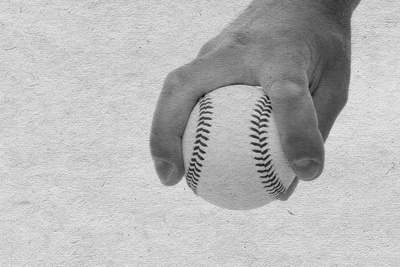
The splitter looks like a two-seam fastball but drops right at the last second. The splitter grip looks very much like a two-seam fastball grip, except your middle and index fingers are placed outside the seams as seen in the picture above.
The delivery and release is just like a two-seam fastball pitch. The ball will start dropping during the last 15 feet in flight.
Roger Craig is credited with inventing the pitch. Bruce Sutter, David Cone, and Rich Harden used the splitter effectively during their careers.
Knuckleball
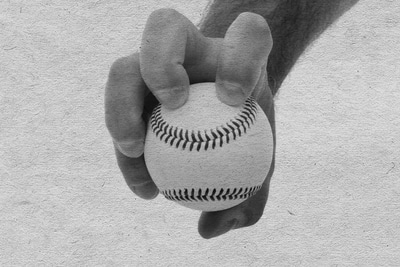
The knuckleball plays mind games with the batter. It has an erratic motion that makes it hard for the batter to hit. From the batter’s point of view the ball looks like it’s floating while making darting movements in different directions. What gives a knuckleball its weird motion is that there’s hardly any spin on the ball. Scientific America actually went into some detail in explaining the physics of a knuckleball. Here’s what they had to say:
For a knuckleball, the important thing is that the ball rotate about an axis so that the seams are on one side of the front of the ball at one instant, whereas a little later they are on the other side of the front of the ball. The ball will then drift in the direction of the leading seam, and then drift back when the seam becomes exposed on the other side. The seams produce turbulence in the air flowing around the ball, disturbing the air layer traveling with the ball and thereby producing a force on the ball. As the ball slowly rotates, this force changes, causing the ball to “flutter” and slowly drift.
Got that? Good, because there will be a test on it.
To grip the knuckleball, position the ball in the same way as you would in the two-seam fastball or the splitter. Now, instead of laying your fingers along the seam of the ball, dig your fingertips into the leather. Don’t touch the seams at all. (See picture above). Place your thumb directly under the ball. Again, don’t touch the seam.
When you release the ball, keep your wrist stiff and extend your fingers as you release the ball. Imagine you’re trying to push the ball to the catcher.
The knuckleball is the slowest pitch, and it’s the most difficult to throw. Because of it’s unpredictable motion, knuckleballs can result in a lot of wild pitches.
Lew “Hicks” Moren is credited with inventing the knuckleball during the 1900s, but Eddie Cicotte is often associated with the pitch mainly because of his fame from the Black Sox Scandal. There are only two MLB pitchers today who use the knuckleball: Tim Wakefield and Charlie Haeger.
Thursday, May 13, 2010
Wednesday, May 12, 2010
Simplify Tips
From the DLM Blog:
The Bare Essentials: Simplifying Your Life
Posted: 11 May 2010 07:12 AM PDT

Take a look in your closets, garage, junk drawer and even your day planner. Are your valuable spaces uncomplicated and organized or cluttered and cramped? If your answer is the latter, it may be time to simplify your life by getting down to the bare essentials.
For many people, a good number of items which currently clutter up your home are redundant, useless, in need or repair, or just taking up space. We simply do not need all of the possessions we have accumulated. These superfluous items can cost you valuable time and money as you sort through them on a daily basis. Simplification and getting down to the bare essentials will save time and money while reducing stress as well. Although there are many areas of our lives we could simplify, here are a few examples to give you a good start.
- Simplify your wardrobe.
Most people wear less than 20% of the items in their closet on a regular basis. A simplified wardrobe can relieve a great deal of stress. Fewer options will expedite your outfit selection each morning. Stick to mix and match clothing pieces that are classic and timeless. Eliminate items that our outdated, waiting more than 6 months for repair or alterations, or worn less than twice a year. The increased space in your closet will also make it easier to view the remaining clothing you have. - Simplify your garage and storage area.
As the seasons change, swap snow shovels and ice picks for rakes and garden shovels. Store the unused items above in the rafters. If you have multiples of outdoor tools, garden tools, or sporting equipment, select the one in the best condition, and eliminate the others. Most importantly, if you have boxes in your storage area or garage that have been unopened for over two years, consider discarding it. If it's been stored that long, you likely don't need it. - Simplify your children's toys.
Some toys, such as building blocks, are a staple in a child's toy repertoire and should be kept. Classic games and toys should be retained so long as they are regularly played with. Others like board games or puzzles which are missing pieces, trendy toys (remember Tickle Me Elmo?) that now sit on the shelf collecting dust, or gifted items that your children never had any real interest in should be discarded or donated. More than likely, your child will never miss those items and their playroom shelves will look considerably less cluttered. - Simplify your kitchen.
Keep your cupboards organized by eliminating dishes and appliances you rarely use. You only need enough dishes to serve your family and a reasonable number of guests. Donate any extras. A single set of mixing bowls and cooking utensils is all that is necessary. While decluttering the kitchen, take a look under the sink and combine or discard multiples of cleaning supplies as well. Then find time to take a look through your pantry and donate any non-perishables you will not eat in the next month to a food bank. - Simplify your finances.
Multiple credit cards make it easy to accumulate debt and easy to miss a payment as well. If you have debt, consolidate it into one loan or credit card. An even better option is to become debt-free. If you are married and still have separate accounts, merge them into one. If you have money in the stock market, buy and hold rather than playing the ups and downs. Package services such as insurance (car, home, life) and technology Internet, cable, phone) whenever possible. One bill is easier to keep track of than three. In addition to simplification, you may find that packaged services at a discounted rate as well. - Simplify your schedule.
Avoid taking on too many social engagements. Carefully consider your availability before joining any groups, committees, or clubs. Limiting your social commitments will allow you do give each its due attention. Additionally, simplify your family obligations by grouping appointments together whenever possible. Take one trip to the dentist instead of 5 separate trips. If your children are involved in after-school activities, find another family that will carpool with you. Life is much simpler when you only need to drive the kids to soccer once a week instead of 3 times.
benefits along the way such as reduced stress, increased personal satisfaction, and more free time.
 | Written on 5/11/2010 by Maria Gracia. Maria is the founder of www.GetOrganizedNow.com and specializes in helping people get better organized to live the kind of stress-free life they've always dreamed of. Visitors to her web site can get a FREE Get Organized Now! Idea-Pak and sign up for her weekly organizing newsletter. | Photo Credit: Ssmallfry |
Tuesday, May 11, 2010
Tech Tuesday Tip

This time, a few personal tips from my own experience. And a disclaimer too.
First the disclaimer: Use at your own risk. I'm not responsible for this screwing up your computer.
However, on the other hand, the only time in the past 10 years that I've taken a computer to a professional, I knew more than he did.
Yesterday I helped a co-worker revive a "dead" laptop. It was out of commission for the past 5 months. It wasn't really dead, it would hang when it was starting up. The most difficult part of the problem was he was using Windows Vista and only had one user account. I have Vista on my laptop and XP on a desktop and discovered a few years ago the value of having more than one user account with administrator privileges.
If your user account gets messed up, you can often still sign on using the backup user and restore/fix the problem.
So, go ahead and set up that back up user account now, even if you are the only one who will ever use your computer. It may save you some big bucks in the future.
Monday, May 10, 2010
Sunday, May 09, 2010
Remembering

This is Mothers Day in the United States.
Everyone has or had a mother.
If she is alive, she needs to hear from you.
If she is alive, you need to hear her voice too.
There will come a day when that will no longer be possible.
Funny thing about life... it is fatal.
My Dad's mother died the year I was born so I never knew her.
My Mom's mother died when I was 26, she was the only living grandparent I ever had.
It was on this weekend a dozen years ago that I helped my Dad express his love to my Mom.
See, he was flat on his back, dying in a hospice on Mothers Day. It was a tradition of his to always give my Mom a rose on Mothers day, so I went out and bought one and helped him sign the card.
The next day we received word that he had passed away.
For the next three years my Mom lived as a widow. She missed my Dad with all her heart until her heart gave out on Thanksgiving eve 2001.
It's not too late.
Don't ignore this day, Mothers Day. It is ALWAYS the 2nd Sunday of May.
(And while were at it, don't ignore Fathers Day. It is ALWAYS the 3rd Sunday of June.)
Ignore the hurts, forgive the past, and cherish the relationships.







